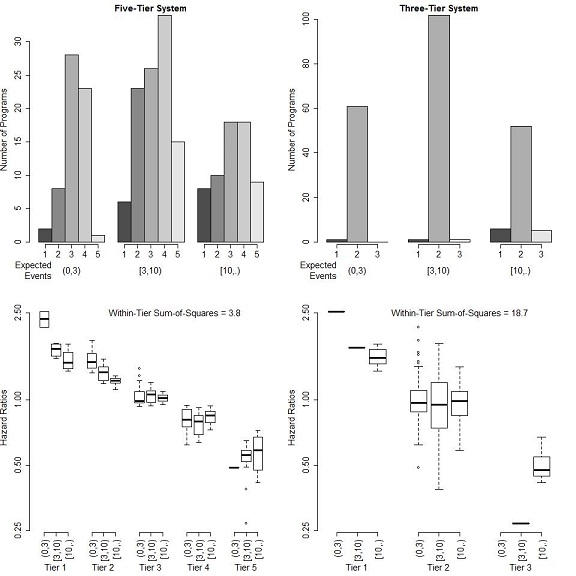Improving Communication of SRTR Transplant Program Outcomes Evaluations Using a 5-Tier System.
Scientific Registry of Transplant Recipients, Minneapolis
Meeting: 2017 American Transplant Congress
Abstract number: 201
Keywords: Methodology
Session Information
Session Time: 8:30am-9:30am
 Presentation Time: 8:30am-8:45am
Presentation Time: 8:30am-8:45am
Location: Arie Crown Theater
SRTR developed a 5-tier outcome assessment to improve the accessibility and understanding of the program outcomes evaluations SRTR performs as mandated by the Final Rule (OPTN Final Rule 121.11(b)(iv)). SRTR has historically summarized program performance into 3 tiers based on first-year posttransplant survival. These 3 groups, labeled “higher than expected,” “as expected,” and “lower than expected,” were determined based on whether the 95% credible interval of the hazard ratio included 1 (as expected), was greater than 1 (lower than expected), or was less than 1 (higher than expected). SRTR is replacing this system with a 5-tier outcome assessment. The tiers are determined by first transforming the Bayesian posterior distribution of the hazard ratio into a single performance score using a scoring function, and subsequently assigning programs to tiers of similar performance. The performance of the 5-tier system was compared with the performance of the 3-tier system for adult kidney programs operating January 1, 2012-June 30, 2014 (38,471 transplants at 229 programs). For both the 5- and 3-tier systems, we evaluated the misclassification rate and the variability of hazard ratios within each tier (“within-tier sum-of-squares”). Figure 1 presents the distribution of tiers for the 5-tier and 3-tier systems (top panels) and the distribution of estimated program hazard ratios within tiers (bottom panels) within groupings of small-, medium-, and large-volume programs as defined by the program's expected number of events. The hazard ratios were relatively well ordered by the 5-tier system with higher hazard ratios in lower tiers. In contrast, the 3-tier system showed substantial variability in the hazard ratios of tier-2 programs, ranging from 0.5 to 2.0. Thus, the 5-tier system reduced the within-tier sum-of-squares by 80% compared with the 3-tier system, indicating improved classification of program performance. The new 5-tier system will better inform healthcare consumers of transplant outcomes at programs by improving differentiation between programs and maintaining a relatively low misclassification rate for over- and under-performance.
CITATION INFORMATION: Snyder J, Wey A, Salkowski N, Israni A, Kasiske B. Improving Communication of SRTR Transplant Program Outcomes Evaluations Using a 5-Tier System. Am J Transplant. 2017;17 (suppl 3).
To cite this abstract in AMA style:
Snyder J, Wey A, Salkowski N, Israni A, Kasiske B. Improving Communication of SRTR Transplant Program Outcomes Evaluations Using a 5-Tier System. [abstract]. Am J Transplant. 2017; 17 (suppl 3). https://atcmeetingabstracts.com/abstract/improving-communication-of-srtr-transplant-program-outcomes-evaluations-using-a-5-tier-system/. Accessed December 22, 2025.« Back to 2017 American Transplant Congress
